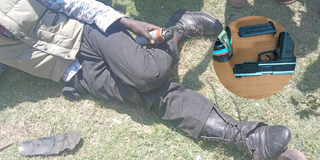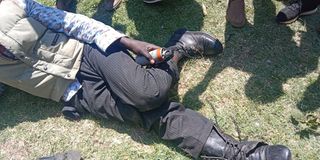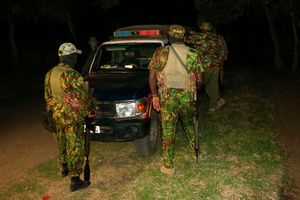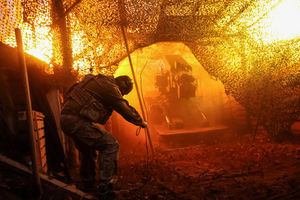
One person was arrested in Nyakach, Kisumu, after he was found with a tear gas canister and crude weapons during ODM grassroots elections.
An emerging disturbing trend of tear gas canisters in civilian hands is adding a new dangerous twist to political violence.
Classified as weapons that should only be wielded by law enforcement officers, tear gas canisters are increasingly being used to disrupt political gatherings, raising questions about how civilians are accessing such dangerous explosives and who is facilitating the crime.
On April 9 in Nyakach, Kisumu County, a man was arrested en route to disrupt the Orange Democratic Movement (ODM) sub-County elections at Kodingo Chief’s Camp.
Police say the man had a tear gas canister and a cache of crude weapons, including knives and machetes. His four accomplices, however, fled.
On the same day, about 108 kilometers away in Bondo, Siaya County, another disturbing incident unfolded after a vehicle was vandalized at Koyucho Junction. During a search, a fake pistol and another tear gas canister were discovered.
Police believe the weapons were also intended to be used to sabotage ODM elections in the area.
Bondo sub-County Police Commander, Mr Robert Aboki, confirmed the arrests of two suspects traveling in a Toyota Passo.

Police in Bondo have launched investigations after they confiscated a tear gas canister and a fake pistol.
“We are investigating where they got the teargas canister and their intentions,” Mr Aboki said. “We are also waiting for the car owner to come forward so we can trace who hired it.”
Troubling pattern
But beyond these incidents lies a deeper, more troubling pattern - one that implicates not only rogue civilians but also corrupt officers as well as dangerous politicians in the proliferation of these weapons.
The Nation spoke to multiple sources, some from within the police force, who revealed that the trade in tear gas canisters is part of an underground network, involving corrupt police officers, unscrupulous politicians and reckless civilians.
One police officer, who requested anonymity due to the sensitivity of the matter, admitted that some officers routinely divert tear gas canisters for sale.
“You’re given 10 canisters for crowd control, you discharge three but instead of returning seven, you take back two and retain five. No one questions you,” he claimed.
“Unlike guns, canisters don’t have serial numbers, so they’re harder to trace,” he added.

One person arrested in Nyakach, Kisumu, after he was found with a tear gas canister and crude weapons during ODM grassroots elections.
According to the officer, some protesters even collect unexploded canisters after demos and keep them for future use. Others, emboldened by the sense of power, wear them on their waists like trophies during demonstrations.
“There are also officers who show off. They carry tear gas in their cars to impress friends or family, not realizing the risk they’re creating,” he added.
Top cops involved
A private security guard hired by politicians and VIPs confirmed that some of the shady deals are orchestrated with the knowledge of senior officers.
“It happens with the blessings of ‘Wakubwa’- the bosses. Politicians pay small bribes and officers provide youths with tear gas canisters to disrupt rival events,” he claimed.
These youths, often trained in basic handling techniques, are then deployed to lob canisters at political rallies, with few ever being arrested or prosecuted.
The misuse of tear gas is not new. In 2016, during a rally at Masinde Muliro Gardens in Kakamega, multiple canisters were thrown at the dais while Ford Kenya leader Moses Wetang’ula launched his presidential bid.
Although two suspects were attacked by the crowd, their identities and whether they were ever prosecuted is still unclear.
In November 2021, another incident occurred in Migori County during the gubernatorial campaign launch of former County Secretary Christopher Rusana. A canister thrown into the crowd caused chaos, but no suspect was ever formally charged.
Even law enforcement officers haven’t been exempt from blame. In December last year, a police officer in Shamata, Nyandarua was arrested by citizens after throwing a teargas canister at a prayer service attended by senior political figures, including former Deputy President Rigathi Gachagua.
In 2023, two civilians, Paul Mwangangi Mutinda and Jeremiah Ngigi Mburu, were convicted for possessing tear gas canisters, hand grenades and a police radio.
Though another suspect, a police deserter, was acquitted due to insufficient evidence, the case highlighted the increasing accessibility of military-grade equipment by ordinary citizens.
Deny blame
Despite the growing number of incidents, police have consistently denied institutional involvement. Mr Aboki insists that the canisters found in civilian hands are remnants of past demonstrations.
“Some people pick up unexploded ones and keep them. It’s not the police distributing them,” he said.
He added that the lack of serial numbers and the disposable nature of canisters make accountability difficult.
But human rights activist Mr Audi Ogada challenges this narrative. “This has been going on for years. The police are at the center of this mess,” he said.
“Tear gas canisters are sold for as little as Sh100 to Sh3,000. If the government won’t tell us how civilians are getting them, who will?” he posed.
Mr Ogada believes the lack of accountability is emboldening criminals, who now outnumber and outgun security officers at political rallies. He called for urgent reforms to tighten control over teargas distribution and use.
“There should always be a designated commander overseeing crowd control, and every canister used must be accounted for,” he said. “Without proper oversight, these weapons will continue to fuel violence.”
He, however, feels that there is no accountability from the commanders who usually give firearms, live bullets and tear gas canisters to those going to quell riots in the field.
“How are these canisters being accounted for so that it is easier to track the criminals? There should be a commander at any given time during an assignment and only one allowed to discharge tear gas to disperse crowds,” said Mr Ogada.









